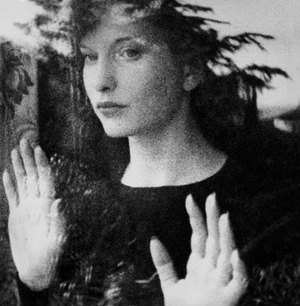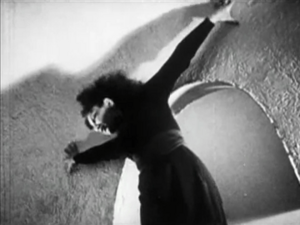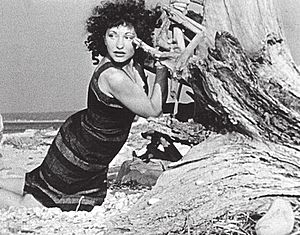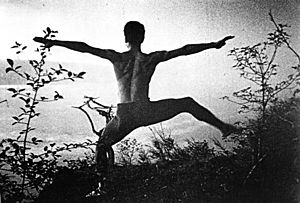Maya Deren facts for kids
Quick facts for kids
Maya Deren
|
|
|---|---|

Deren in the film Meshes of the Afternoon (1943), her debut
|
|
| Born |
Eleonora Derenkowska
May 12 [O.S. April 29] 1917 |
| Died | October 13, 1961 (aged 44) New York, New York, United States
|
| Nationality | American |
| Education | New York University, New School of Social Research, Smith College |
| Known for | Choreography, film, dancing |
|
Notable work
|
Films:
|
| Spouse(s) | Gregory Bardacke (1935–1939) Alexandr Hackenschmied (1942–1947) Teiji Itō (1960–1961; her death) |
| Awards | Guggenheim Fellowship, Creative Work in Motion Pictures, (1947) Grand Prix Internationale for Amateur Film, Cannes Film Festival (1947) |
Maya Deren (born Eleonora Derenkowska, Ukrainian: Елеоно́ра Деренко́вська; May 12 [O.S. April 29] 1917 – October 13, 1961) was an American experimental filmmaker. She was born in Ukraine. Maya Deren was very important in the world of avant-garde (new and experimental) art in the 1940s and 1950s.
She was also a talented choreographer, dancer, film writer, poet, and photographer. Maya Deren believed that films should create a special experience for the viewer. She used her knowledge of dance, culture, and psychology to make unique black-and-white short films.
She used many camera tricks like multiple exposures (showing several images at once) and slow-motion. She also used special editing techniques. This helped her to create films that played with ideas of space and time. Her films were carefully planned with clear goals.
Her first film, Meshes of the Afternoon (1943), was made with Alexander Hammid. It became one of the most important experimental films in American history. She made several other films by herself. These include At Land (1944), A Study in Choreography for Camera (1945), and Ritual in Transfigured Time (1946). She wrote, produced, directed, and edited these films. She even filmed them herself, often with help from only one camerawoman, Hella Heyman.
Contents
Early Life and Education
Maya Deren was born on May 12, 1917, in Kyiv, which is now part of Ukraine. Her family was Jewish. In 1922, her family moved to Syracuse, New York, in the United States. They left Ukraine because of violence against Jewish people. Her father shortened their last name to "Deren" when they arrived in New York.
Maya Deren started college at Syracuse University. There, she studied journalism and politics. She was also active in student social groups. In 1935, she married Gregory Bardacke. She later moved to New York City. She earned a bachelor's degree in literature from New York University in 1936. She then got a master's degree in English literature from Smith College. Her master's paper was about French poetry.
Starting Her Career
After college, Maya Deren returned to Greenwich Village in New York. She joined a group of European artists who had moved there. From 1937 to 1939, she worked as a freelance writer for radio shows and newspapers. She also helped famous American writers with their work.
In 1940, Deren moved to Los Angeles to focus on her poetry and photography. In 1941, she became an assistant to Katherine Dunham. Dunham was a famous African American dancer and choreographer. Dunham's work greatly influenced Deren's interest in Haitian culture and Vodou traditions.
In Los Angeles, Deren met Alexandr Hackenschmied. He was a well-known photographer and cameraman from Czechoslovakia. He became her second husband in 1942. He helped her with her photography.
Becoming a Filmmaker
Maya Deren saw cinema as a true art form. She helped people understand and appreciate independent films. She was very good at promoting her work. She showed and shared her films across the United States, Canada, and Cuba. She also gave talks and wrote about experimental film ideas.
In 1946, she received a special award called a Guggenheim Fellowship. This was for her "Creative Work in the Field of Motion Pictures." She also won a major award at the Cannes Film Festival for Meshes of the Afternoon. She then started a scholarship for other experimental filmmakers.
Between 1952 and 1955, Deren worked with the Metropolitan Opera Ballet School. Together, they created the film The Very Eye of Night.
Her love for dance is clear in her films. A great example is her short film A Study in Choreography for Camera (1945). This mix of dance and film is sometimes called "choreocinema."
Deren often explored ideas about the unconscious mind in her work. This is seen in Meshes of the Afternoon. She also looked at themes of identity and mythology.
Major Films
Meshes of the Afternoon (1943)
In 1943, Maya Deren bought a used 16mm camera. She used it to make her first and most famous film, Meshes of the Afternoon. She made it with Alexander Hammid at their home in Los Angeles. The film cost only $250 to make.
Meshes of the Afternoon is known as a very important experimental film. It was one of the first experimental American films to tell a story. Some people see parts of Maya Deren's own life in the film.
The film was first silent, with no talking. Later, music was added by Deren's third husband, Teiji Itō. The film is like a dream, with dramatic camera angles and creative editing. It explores how a person's unconscious mind works.
In the film, a woman (played by Maya Deren) walks to a friend's house. She falls asleep and has a dream. The scene of her walking to the gate repeats many times. This makes the film feel like a dream, not a normal story. Wind, shadows, and music create a special mood. Certain symbols appear again and again, like a cloaked figure with a mirror for a face, and a key that turns into a knife.
The film's repeating scenes and rhythm make it feel very dream-like. It shows different versions of the woman, suggesting different parts of her self. Critics have called it a "personal film" because it explores the woman's inner world.
At Land (1944)
Maya Deren filmed At Land in New York during the summer of 1944. In this film, Deren wanted to show how the outside world affects our inner feelings.
The film starts with Maya Deren washing up on a beach. She climbs onto a piece of wood that leads her into a room. In the room, men and women are sitting at a long table. She seems invisible to them as she crawls across the table. Her body then moves smoothly into new scenes. She crawls through plants, follows water flowing over rocks, and follows a man across a farm. She goes through many doors and finally appears on a cliff outside.
She looks confused when she sees two women playing chess on the sand. She then runs back through all the scenes. Because of the quick cuts, it looks like there are two of her, or a "doppelganger." Her earlier self seems to see her other self running through the scene. Some of her movements are like a dancer, while others are more like an animal. This film focuses on the character exploring her own feelings in different places.
A Study in Choreography for Camera (1945)
In 1945, Maya Deren made A Study in Choreography for Camera. She said this film was "an effort to show and celebrate the power of movement." The way the dancer moves, along with Deren's careful editing and changing film speeds, creates a dance that could only exist in a movie.
This short film is less than 3 minutes long. It shows a man dancing in a forest. Then, because of the continuous movements, he seems to instantly appear inside a house. The editing is quick and shows different angles. Even with slow-motion parts, Deren makes the dancer's leaps look smooth. The dance is perfectly timed as he moves from nature to a courtyard and back to nature.
The dancer in the film is Talley Beatty, a famous dancer and choreographer. He worked closely with Deren on this film. This film was one of the first experimental dance films to be reviewed in major newspapers and magazines.
Ritual in Transfigured Time (1946)
For her fourth film, Ritual in Transfigured Time, Maya Deren wanted to focus on how time can be used uniquely in film. She also wanted the film to feel like a ritual. This film was finished in 1946.
It explores feelings like the fear of being rejected. It also looks at the freedom that comes from letting go of old ways. The film shows the small details and bigger ideas about how things change. Maya Deren herself, along with dancers Rita Christiani and Frank Westbrook, played the main roles.
Personal Life
In 1943, Maya Deren moved to Hollywood. She started using the name Maya, which her husband Hammid gave her. "Maya" has meanings in different cultures. It is the name of the mother of the Buddha. In Greek stories, Maia is a goddess of mountains and fields.
In 1944, back in New York City, she became friends with famous artists like Marcel Duchamp, André Breton, and John Cage. In 1944, Deren filmed The Witch's Cradle in an art gallery. Marcel Duchamp was in that film.
Maya Deren passed away in 1961, at the age of 44, due to a brain hemorrhage. Her ashes were scattered in Japan at Mount Fuji.
Her View on Hollywood
Throughout the 1940s and 1950s, Maya Deren often spoke out against Hollywood. She believed Hollywood had too much control over American cinema. She felt it stopped film from becoming a true art form.
She famously said, "I make my pictures for what Hollywood spends on lipstick." She believed Hollywood was a "major obstacle" to film being seen as a creative art. She wanted to make films that were very different from Hollywood's style.
Interest in Haiti and Vodou
Maya Deren decided to make a film about the culture in Haiti. Some people wondered why she would leave experimental film, where she was well-known. But she wanted to explore new artistic areas.
In 1947, she traveled to Haiti for nine months. Her Guggenheim Fellowship helped her pay for the trip. She went on three more trips to Haiti until 1954. She wanted to film and record the traditions of Haitian Vodou.
Deren had studied Haitian dances through her work with Katherine Dunham. She filmed many hours of Vodou ceremonies. She also took part in them herself. She wrote a book about her experiences called Divine Horsemen: The Living Gods of Haiti (1953). This book is still considered an important source on the topic.
She filmed 18,000 feet of Vodou rituals. This footage was later used in a documentary film called Divine Horsemen: The Living Gods of Haiti. Her ex-husband, Teiji Itō, and his wife finished and released it in 1977.
Legacy
Maya Deren inspired many other experimental filmmakers. These include Curtis Harrington, Stan Brakhage, and Kenneth Anger. They admired her independent and creative spirit. Her influence can also be seen in films by Carolee Schneemann and Barbara Hammer.
Maya Deren was key in creating a "New American Cinema." This movement focused on personal, experimental, and underground films. In 1986, the American Film Institute created the Maya Deren Award. This award honors independent filmmakers.
Many works have been created about Maya Deren and her films:
- She appears as a character in a long poem by her friend James Merrill.
- In 1987, Jo Ann Kaplan directed a documentary about Deren called Invocation: Maya Deren.
- In 2002, Martina Kudlacek directed a film about Deren called In the Mirror of Maya Deren.
Her films have also been shown with new music:
- In 2004, the British band Subterraneans created new music for six of Deren's short films.
- In 2008, the Portuguese band Mão Morta also made new music for four of her films.
Awards and Honors
- Guggenheim Fellowship (1947)
- Grand Prix Internationale for Amateur Film at the Cannes Film Festival (1947)
Filmography
| Denotes posthumously released |
| Title | Year | Credits | Notes | Ref. | |||
|---|---|---|---|---|---|---|---|
| Director | Writer | Producer | Editor | ||||
| Meshes of the Afternoon | 1943 | Yes | Yes | Yes | Yes | co-directed with Alexander Hammid | |
| The Witch's Cradle | 1944 | Yes | Yes | No | No | unfinished | |
| At Land | 1944 | Yes | Yes | No | No | ||
| A Study in Choreography for Camera | 1945 | Yes | No | No | No | solo starring by Talley Beatty | |
| The Private Life of a Cat | 1947 | Yes | No | No | No | Collaboration with Alexander Hammid | |
| Ritual in Transfigured Time | 1946 | Yes | Yes | Yes | Yes | co-edited by Alexander Hammid | |
| Meditation on Violence | 1948 | Yes | Yes | Yes | No | music by Teiji Itō | |
| Medusa | 1949 | Yes | No | No | No | unfinished | |
| Ensemble for Somnambulists | 1951 | Yes | Yes | Yes | No | Toronto Film Society workshop; unreleased, unfinished | |
| The Very Eye of Night | 1955 | Yes | Yes | No | Yes | collaboration with Metropolitan Opera Ballet School | |
| Season of Strangers | 1959 | Yes | No | No | No | also known as Haiku Film Project, unfinished | |
| Divine Horsemen: The Living Gods of Haiti | 1985 | Yes | No | No | No | Original footage shot by Deren (1947–1954); reconstruction by Teiji and Cherel Itō | |
Discography
Vinyl LPs
| Year | Artist | Title | Label | Notes |
|---|---|---|---|---|
| 1953 | Maya Deren | Voices of Haiti | Elektra Records | Design [cover]: Teiji Itō; recorded during ceremonials near Croix-des-Missions and Pétion-Ville, Haiti |
| 1978 | Unknown | Meringues and Folk Ballads of Haiti | Lyrichord Discs | Recorded by Maya Deren |
| 1980 | Unknown | Divine Horsemen: The Voodoo Gods of Haiti | Lyrichord Discs | Recorded by Maya Deren; design [cover]: Teiji Itō; liner notes: Cherel Ito |
Written Works
Maya Deren was also an important writer about film.
- Her most famous essay on film ideas is An Anagram of Ideas on Art, Form and Film (1946). This book laid out many of her thoughts on film as an art form.
- Her collected essays were published in 2005. They are divided into three parts:
- Film Poetics: This section includes essays like "Cinema as an Art Form."
- Film Production: This part has articles like "Creating Movies with a New Dimension: Time."
- Film in Medias Res: This section features essays such as "New Directions in Film Art."
- Her book Divine Horsemen: Living Gods of Haiti was published in 1953. It is still considered a key book about Vodou.
See also
 In Spanish: Maya Deren para niños
In Spanish: Maya Deren para niños




